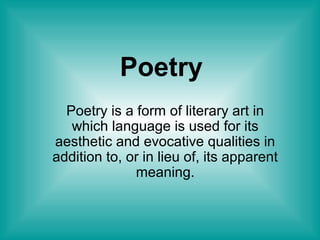
Types of Poetry Explained
- 1. Poetry Poetry is a form of literary art in which language is used for its aesthetic and evocative qualities in addition to, or in lieu of, its apparent meaning.
- 2. • Poetry is language that tells us, through a more or less emotional reaction, something that can not be said. » Edwin Arlington Robinson (1869-1935)
- 3. • Poetry is the utterance of a passion of truth, beauty, and power, embodying and illustrating its conceptions by imagination and fancy, and modulating its language on the principle of variety in uniformity. » Leigh Hunt (1784-1853)
- 4. Types of Poetry Rhymed verse Rhymed verse is the most commonly used form of verse and generally has a discernable meter and an end rhyme. I felt a cleavage in my mind As if my brain had split; I tried to match it, seam by seam, But could not make them fit. The thought behind I strove to join Unto the thought before, But sequence ravelled out of reach Like balls upon a floor. -Emily Dickinson
- 5. Blank verse Blank verse is generally identified by a regular meter, but no end rhyme. Example: In Mathematics, Woman leads the way: The narrow-minded pedant still believes That two and two make four! Why, we can prove, We women-household drudges as we are- That two and two make five-or three-or seven; Or five-and-twenty, if the case demands! -from Princess Ida
- 6. • Free verse Free verse is usually defined as having no fixed meter and no end rhyme. Although free verse may include end rhyme, it commonly does not. Whirl up, sea-- Whirl your pointed pines, Splash your great pines On our rocks, Hurl your green over us, Cover us with your pools of fir.
- 7. • Lyric poetry is a form of poetry with rhyming schemes that express personal and emotional feelings. Aristotle mentions lyric poetry along with drama, epic poetry, dancing, painting and other forms of mimesis. The lyric poem, dating from the Romantic era, does have some thematic antecedents in ancient Greek and Roman verse, but the ancient definition was based on metrical criteria, and in archaic and classical Greek culture presupposed live performance accompanied by a stringed instrument.
- 8. • The sonnet is one of several forms of lyric poetry originating in Europe. it had come to signify a poem of fourteen lines that follows a strict rhyme scheme and specific structure. • One of the best-known sonnet writers is William Shakespeare, who wrote 154 of them (not including those that appear in his plays). A Shakespearean, or English, sonnet consists of 14 lines, each line containing ten syllables and written in iambic pentameter, in which a pattern of an unemphasized syllable followed by an emphasized syllable is repeated five times. The rhyme scheme in a Shakespearean sonnet is a- b-a-b, c-d-c-d, e-f-e-f, g-g; the last two lines are a rhyming couplet.
- 9. “Shall I compare thee to a summer’s day?” Shall I compare thee to a summer’s day? (a) Thou art more lovely and more temperate: (b) Rough winds do shake the darling buds of may, (a) And summer’s lease has all too short a date: (b) Sometimes too hot the eye of heaven shines, (c) And often is his gold complexion dimm’d: (d) And every fair from fair sometime declines, (c) By chance, or nature’s changing course, untrimm’d. (d)
- 10. But thy eternal summer shall not fade (e) Nor lose possession of that fair thou owest; (f) Nor shall death brag thou wanderest in his shade, (e) When in eternal lines to time thou growest: (f) So long as men can breathe or eyes can see, (g) So long live this, and this gives life to thee. (g)
- 11. • A ballad is a form of verse, often a narrative set to music. Ballads are written in ballad stanzas or quatrains (four-line stanzas) of alternating lines of iambic (an unstressed followed by a stressed syllable) tetrameter (eight syllables) and iambic trimeter (six syllables), known as ballad meter. Usually, only the second and fourth line of a quatrain are rhymed (in the scheme a, b, c, b), which has been taken to suggest that, originally, ballads consisted of couplets (two lines) of rhymed verse, each of fourteen syllables.[3] As can be seen in this stanza from ‘Lord Thomas and Fair Annet’: • The horse| fair Ann|et rode| upon| He amb|led like| the wind|, With sil|ver he| was shod| before, With burn|ing gold| behind|.
- 12. References Associate Professor Surapipan Chantraporn. 1996. Poetry: anintroductory study. Bangkok: Chulalongkorn University Printing house. http://www.buzzle.com/articles/kinds-of-poetry.h http://www.contemporary lit.about.com/od/poetry/a/poetry.htm http://en.wikipedia.org/wiki/Verse
- 13. Members of Group • 1. Sofia Wong arirak 5220117015 • 2. Nasuha Kaseng 5220117032 • 3. Khadiyah Daseng 5220117143 • 4. Suhaida Salaemae 5220117158
